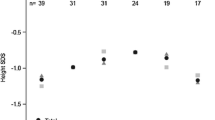Abstract
Growth Hormone being very expensive in India data on use of recombinant human growth hormone (rhGH) is scarce. The authors studied the effect and safety of one year of therapy with rhGH on growth velocity and predicted final height in Indian patients with growth hormone deficiency (GHD). A multicentric, prospective, open trial with rhGH was performed on 15 patients. Patients received rhGH in a dose of 0.7 IU (0.23 mg)/Kg/week. The mean pretreatment height was 111.2cms {SD 12.4}, height velocity was 3.1 cms per year {1.2} and predicted height was 146.5 cms {10.4} at a mean age of 12.0 (2.8). At the end of therapy mean height was 123.4 {11.9}, height velocity was 12.1 cms per year {2.8} and the predicted height was 153.0 cm {9.4}. The increase in predicted height was thus 6.5cm (4.2). The increment in height velocity with growth hormone therapy was statistically significant (p value= 0.001). The present study shows that children with growth hormone deficiency in India also benefit from therapy with rhGH even when treatment is started late as compared to the published Western data and there is a potential for increased final height.
Similar content being viewed by others
References
Flodh H. Update on clinical use and experience of somatonorm (somatrem). Acta Pediatr Scand 1987; 337: 130–133.
Menon PSN, Virmani A, Sethi AK. Biosynthetic Growth hormone Therapy in children with Growth Hormone efficiency: Experience at AIIMS, New Delhi. Indian J Pediatr 1991; 58: 71–77.
Raghupathy P. Growth Hormone Deficiency: A Vellore Experience: 1986–1990. Indian J Pediatr 1991; 58: 79–79.
Tanner JM, Healy MJ, Goldstein H, Cameron N. Assessment of skeletal maturity and prediction of adult height (TW3 method). 3rd ed. London; WB Saunders; 2001.
Agarwal DK, Agarwal KN, Upadhyay SK, Mittal R, Prakash R, Rai S. Physical and sexual growth pattern of affluent Indian children from 5–18 years of age. Indian Pediatrics 1992; 29: 1203–1282.
Dehiya RD, Bhartiya D, Kapadia C, Desai MP. Insulin Like Growth Factor-1, Insulin Like Growth Factor Binding Protein-3 and Acid Labile Subunit Levels in Healthy Children and Adolescents in Mumbai Suburbs. Indian Pediatrics 2000; 37: 990–997.
Tanner JM, Whitehouse RH, Takaishi M. Standards from birth to maturity for height, weight, height velocity and weight velocity: British children 1965. Arch Dis Child 1966; 41: 454–471.
Frasier SD. Human pituitary growth hormone (hGH) therapy in growth hormone deficiency. Endocrine Reviws 1983; 4: 155–156.
Bundak R, Hindmarsh PC, Smith PJ, Brook CG. Long-term auxological effects of human growth hormone. J Pediatr 1988; 112: 875–879.
Ranke MB, Bierich JR. Long term treatment of hypopituitarism. In Ranke MB, Bierich JR, eds. Growth Hormone Deficiency. Baltimore; Urban and Schwarzenber; 1983.
Cowell CT, Dietsch S, Greenacre P. Growth Hormone therapy for 3 years: The OZGROW experience. J Peditr Child Health 1996; 32: 86–93.
Darendeliler F, Hindmarsh PC, Brook CG. Dose-response curves for treatment with biosynthetic human growth hormone. J Endocrinology 1990; 125: 311–316.
Frasier D, Costin G, Lippe BM, Aceto T, Bunger PF. Dose response curve for human growth hormone. J Clin Endocrinology & Metabolism 1981; 53: 1213–1217.
Hindmarsh PC, Brook CGD. Normal Growth and its Endocrine control. In Clinical Pediatric Endocrinology, 3rd edn. Ed. Brook CGD. London, Blackwell Science, 1995; 185–106.
Bavdekar A, Yajnik CS, Fall CH, Bapat S, Pandit AN, Deshpande V, Bhave S, Kellingray SD, Joglekar C. Insulin resistance syndrome in 8-year-old Indian children: small at birth, big at 8 years, or both? Diabetes 1999; 48(12): 2422–2429.
Desai MP, Colaco MP. Growth Hormone Deficiency and Insensitivity. In: Desai MP, Bhatia V, Menon PS, eds. Pediatric Endocrine Disorders. 1st ed. Hyderabadh; Orient Longman; 2001; 87–105.
Reserve Bank Of India. Handbook of Statistics on Indian Economy. Reserve Bank of India 2004.
Author information
Authors and Affiliations
Corresponding author
Rights and permissions
About this article
Cite this article
Khadilkar, V.V., Khadilkar, A.V., Nandy, M. et al. Multicentric study of efficacy and safety of growth hormone use in growth hormone deficient children in India. Indian J Pediatr 74, 51–54 (2007). https://doi.org/10.1007/s12098-007-0027-9
Published:
Issue Date:
DOI: https://doi.org/10.1007/s12098-007-0027-9




